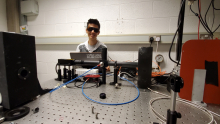
University:
Major:
Site Abroad:
Mentor(s):
Faculty Sponsor(s):
Faculty Sponsor's Department:
Project Title:
Project Description:
Upconverting nanoparticles (UCNPs) have fallen under the spotlight among diverse but increasingly intertwined fields of research, owing to their capacity to convert low-energy photons to higher energy ones, in a process formally called an Anti-Stokes shift. Combined with a host of other favorable properties such as long luminescence times, high photochemical stability, and low cytotoxicity, UCNPs have become invaluable not only in pure photonics, where they have been used to broaden the spectral absorption of solar cells, but also in medicine for imaging biological systems, chemical detection, drug delivery, and cancer treatment. Our lab is investigating a promising method of coupling UCNPs to plasmonic gold nanostars to improve their efficiency, a challenging but crucial step for their practical adaptation to such applications. Plasmonic structures locally enhance applied electromagnetic fields due to the resonant oscillations of the free electron gas in metals; star structures are particularly suited to induce this effect owing to their multiple sharp tips, which allow for high field enhancement and numerous resonance frequencies per nanostar. After synthesizing different batches of UCNPs varying in size and chemical dopants, we gathered their absorbance and emission spectra using UV-visible light and near-infrared laser irradiation respectively. The concentration of UCNPs in each batch was compared by collecting the absorbance spectra of relative dilutions of the original solution, and fitting the UCNP’s characteristic spectral absorbance peaks to Beer-Lambert’s law. The spectral emission intensity was measured as a function of incident laser power and relative UCNP concentration, revealing that the synthesized nanoparticles displayed strong upconversion in agreement with theory. The next step is to combine the UCNPs with the plasmonic gold nanostars and compare their quantum efficiencies. These efforts will enhance our understanding of the UCNPs’ optical phase space and will direct future development towards their widespread adaptation in the public sphere.
